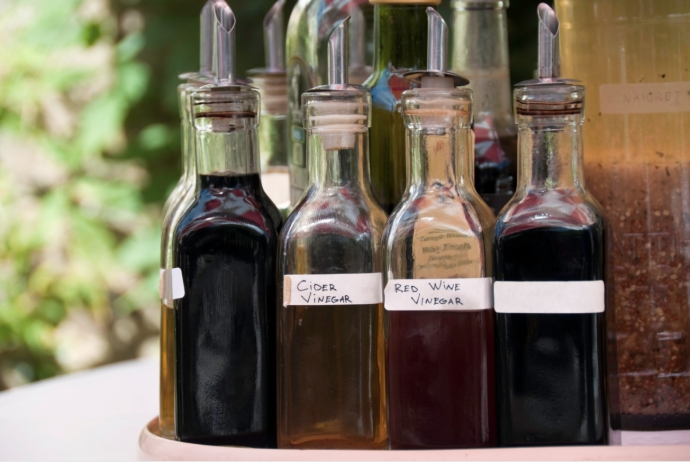7 Types Of Vinegar—And How To Use Them

When I started cooking, my pantry slowly filled up with different kinds of vinegar. I needed one for a recipe, bought it, took a few tablespoons - and that was the end of our relationship. We were strangers, and the shelf space I lost made for an awkward bond. Until I decided to try them, incorporate them into my dishes, and experiment. As you get comfortable with the bottles you have, you'll find yourself using them in dishes you might not have thought of before. If you can not stand even a drop of acid (my husband would object), start by making a simple vinaigrette with a different vinegar each night. You'll find that different oils (grassy olive oil, neutral grapeseed oil, or nutty sesame oil) are just as essential to your cooking as different vinegars.
To find out what you already have and how to use it - or simply to inspire you to deviate from your favourite balsamic - here's a rundown of the most common vinegars worth discovering. From salads to sauces, this staple can be used to enhance so many dishes.
1. Apple cider vinegar
Apple cider vinegar is an indispensable part of the pantry. It's especially good for pork dishes (for marinades or as an addition to a chutney), for recipes with apples or cabbage, or for a smoky, sweet barbecue sauce. It's great for vinaigrettes and can be substituted for red wine vinegar in a pinch. A few quick splashes will also add balance to your soup or stew.
This vinegar is made from fermented apple juice and adds a fruity, slightly sweet flavour to anything it's prepared. It has a light brown colour and is available as a clear liquid or in cloudy, unfiltered versions. They're interchangeable in the kitchen; the unfiltered is more likely to be unpasteurized or organic, and some people prefer the unfiltered because it's less refined.
2. Balsamic Vinegar
Balsamic vinegar is one of the most complex and flavorful vinegars. It can be used as an ingredient in a recipe (marinades, soups and braises, spicy vinaigrettes) or reduced to a sauce. Refined, aged versions can be drizzled on fruit or cheese.
The sweet, complex flavours of balsamic vinegar develop when this dark, reddish vinegar is fermented from grape must (freshly pressed grapes, as opposed to wine vinegar, which is made from fermented red wine) and aged in barrels for at least 12 and up to 25 years. Older vinegars are more flavorful and thicker as they're further concentrated during ageing (they're also more expensive).
It's easy to be perplexed when looking at a grocery shop shelf full of variety and prices. here, the wisdom should apply, "You get what you pay for." That doesn't mean you have to blow your budget: A younger bottle (around $15) is perfect for everyday use in the kitchen. Look for bottles labelled aceto balsamico tradizionale, because using the word "balsamico" as the sole name for a type of vinegar isn't mandatory. (True balsamico is certified by the Italian government and comes from the Modena or Reggio Emilia regions of Italy) Also check the label to make sure grape must is included as an ingredient. Some cheaper balsamic products contain caramel colour and regular wine vinegar as ingredients.
3. White Balsamic
White balsamic is a milder version of red balsamic and is made by pressure cooking the wine must to prevent it from caramelising or taking on a colour. White balsamic is useful when you don't want to add colour to a dish or prefer a slightly purer, less sweet taste.
4. White distilled vinegar
White vinegar is a workhorse in the kitchen. It's not only used for cooking, but also as a cleaning agent. But I also use it a lot in cooking. It's not particularly refined and tastes rougher than other vinegars, but its clean, neutral tartness makes it a perfect base for adding your own accents (honey, herbs, spices, mustard) to create vinaigrettes, marinades, or pickling liquids. You'll taste white vinegar in ketchup, where it perfectly balances the overall sweet and savoury flavours of the tomato, and it's perfect for summer when it spices up a creamy potato salad.
5. Wine vinegar
Both red and white wine vinegars are made from fermented wine. Their flavour is less complex than balsamic or sherry vinegar, but more flavorful and less pungent than white vinegar (without the fruity notes of apple cider vinegar). Both are indispensable in the kitchen.
6. Red wine vinegar
Red wine vinegar is stronger, has brighter notes, and is bolder than white wine vinegar. Use red wine vinegar for dishes that need an extra zing and need something that can stand up to robust flavours: think salads to which you add cheese or creamy elements, red meat marinades, and bean or lentil dishes.
7. Champagne Vinegar
Champagne vinegar is made much like wine vinegar and is the fermented product of the two grape varieties used to make Champagne - Cardonnay and Pinot Noir. It's mild and less acidic than apple cider vinegar or white wine vinegar and is perfect if you're looking for a smooth, delicate flavour for a lighter dish.
